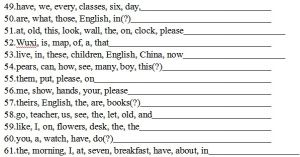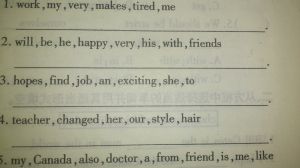連詞概述
 連詞事例
連詞事例連詞與結構
並列連詞引導兩個並列的詞、詞組或句子。1)and 與or
判斷改錯:(錯)They sat down and talk about something.
(錯)They started to dance and sang.
(錯)I saw two men sitting behind and whisper there.
(對)They sat down and talked about something.
(對)They started to dance and sing.
(對)I saw two men sitting behind and whispering there.
解析:
第一句: and 連線兩個並列的謂語,所以 talk 應改為 talked。
第二句:and 連線兩個並列的動詞不定式,第二個不定式往往省略to,因此sang 應改為 sing。
第三句:and 連線感觀動詞saw 後面的用作的賓補的兩個並列分詞結構,因此whisper應改為whispering。
注意:and 還可以和祈使句或名詞詞組連用表示條件。(or也有此用法)例如:
Make up your mind, and you'll get the chance. 拿定主意,這次你會有機會的。
= If you make up your mind, you'll get the chance.
One more effort, and you'll succeed. 再努力一下,你會成功的。
= If you make one more effort, you'll succeed.
2)both…and 兩者都。例如:
She plays (both) the piano and the guitar. 她彈鋼琴,也彈吉他。
3)not only…but (also), as well as不但…而且。例如:
She plays not only the piano, but (also) the guitar. 她不但彈鋼琴,也彈吉他。
注意:not only… but also 關聯兩個分句時,一個分句因有否定詞not 而必須倒裝。例如
Not only does he like reading stories, but also he can even write some.他不但喜歡讀小說,甚至還會寫。
4)neithe…nor 意思為"既不……也不……"謂語動詞採用就近原則,與nor後的詞保持一致。例如:
Neither you nor he is to blame. 你和他都不該受指責。
比較and和or
 連詞成句
連詞成句2) 但有時and 也可用於否定句。請注意其不同特點:
There is no air or water in the moon.
There is no air and no water on the moon.
在否定中並列結構用or 連線,但含有兩個否定詞的句子實際被看作是肯定結構,因此要用and。
典型例題
---I don't like chicken ___ fish.
---I don't like chicken, ___ I like fish very much.
A. and; and B. and; but C. or; but D. or;and
答案C。否定句中表並列用or, but 錶轉折。
判斷改錯:(錯)We will die without air and water.
(錯)We can't live without air or water.
(對)We will die without air or water.
(對)We can't live without air and water.
選擇並列結構
1)or意思為"否則"。例如:I must work hard, or I'll fail in the exam. 我要努力學習,否則考試要不及格了。
2)either…or 意思為"或者……或者……"。注意謂語動詞的主謂一致採用就近原則。例如:
Either you or I am right. 不是你對,就是我對。
轉折或對比
1) but表示轉折,while表示對比。例如:Some people love cats, while others hate them.有些人喜歡貓,而有些人不喜歡。
典型例題
--- Would you like to come to dinner tonight?
--- I'd like to, ___ I'm too busy.
A. and B. so C. as D. but
答案D。but與前面形成轉折,符合語意。而表並列的and, 結果的so,原因的as都不符合句意。
2) not…but… 意思為"不是…而是…",後面的用詞要遵循一致原則。
They were not the bones of an animal, but (the bones) of a human being. 這些不是動物的骨頭,而是人的。
表示原因關係
1) for是並列連詞,不能置於含兩個並列分句的句子的句首,只能將其放在兩個分句中間。判斷改錯:(錯) For he is ill, he is absent today.
(對) He is absent today, for he is ill.
2) so為連詞, therefore一般為副詞。例如:
He hurt his leg, so he couldn't play in the game. 他的腿受傷了,不能上場。
I think; therefore I exist. 我思故我在。
比較so和such
such 是形容詞,修飾名詞或名詞詞組,so是副詞,只能修飾形容詞或副詞。so 還可與表示數量的形容詞many,few,much, little連用,形成固定搭配。so + adj. such + a(n) + n.
so + adj. + a(n) + n.such + n. (pl.)
so + adj. + n. (pl.) such +n. (pl.)
so + adj. + n. (不可數) such +n.(不可數)
so foolish such a fool
so nice a flower such a nice flower
so many/ few flowers such nice flowers
so much/ little money. such rapid progress
so many people such a lot of people
so many 已成固定搭配,a lot of 雖相當於 many,但 a lot of 為名詞性的,只能用such搭配。so…that與such…that之間的轉換即為 so與such之間的轉換。
四關鍵點
連詞while是聯考一個命題的熱點(每年必考),你知道其考點主要涉及哪些方面嗎?
一、考查表示時間的用法,其意為“當……的時候”。如:
We must strike while the iron is hot. 我們要趁熱打鐵。
Stand still while I take your photograph. 我給你拍照時站著不要動。
Have we got enough books to read while we are on holiday? 假期里我們有足夠的書看嗎?
Were there any calls for me while I was out? 我出去的時候,有人來過電話嗎?
She hates anyone listening while she is telephoning. 她打電話時不願讓任何人聽。
二、考查表示讓步的用法,其意為“儘管”“雖然”。如:
While the work was difficult, it was interesting. 雖然工作有難度,但很有趣。
While I understand what you say, I can’t agree with you. 雖然我理解你的意思,但我還是不同意。
三、考查表示對比的用法,其意為“而”“但”。如:
Some people waste food while others haven’t enough. 一些人糟踏食物而另一些人卻食不果腹。
I went swimming while the others played tennis. 我去游泳,而其餘的人則去打網球了。
Prices are rising sharply, while incomes are lagging far behind. 物價飛漲而收入卻遠遠落後。
註:這樣用時,while引出的句子通常位於末,但有時也可位於句首。如:
While most children learn to read easily, some need extra help. 大多數兒童學會閱讀很容易,有一些兒童卻需要特別幫助。
While Deauville is a holiday resort, Trouville is more of a working town. 特維爾是個度假勝地,而特魯維爾更多的卻是個工業城市。
四、考查其省略用法,即主句與從句主語相同,且從句謂語動詞含有動詞be時,通常可省略從句主語和動詞be。如:
While (he was) in prison, she wrote her first novel. 她在獄中寫出了第一部小說。
He had strayed from home while still a boy. 他小時候就離開家到處流浪了。
He fell asleep while (he was) doing his homework. 他做著做著功課就睡著了。
I was only listening to the radio with half an ear, while (I was) preparing some food. 我正在做吃的東西,沒太留心聽收音機。
【考點實訓】
01. She just sits there reading her story book, _________ I do all the work.
A. until B. while B. because D. though
02. Their economy has expanded enormously, _________ ours, by contrast, has declined.
A. while B. unless B. in case D. which
03. Could you watch my bags for me, _________ I go to the toilet?
A. though B. unless B. what D. while
04. The professor is typing his own letters _________ his secretary is ill.
A. what B. which B. if D. while
05. She said she was going to the shops and sked me whether I wanted anything _________ she was out.
A. though B. while B. which D. before
06. Tea is the most popular drink, _________coffee comes second.
A. since B. until B. what D. while
07. Schools in the north tend to be better equipped, _________ those in the south are relatively poor.
A. since B. before B. while D. because
08. It is no accident that men fill most of the top jobs in nursing, _________ women remain on the lower grades.
A. after B. since B. while D. which
09. _________ trying to open the can, I cut my hand.
A. Though B. Because B. For D. While
10. Some people prefer a vegetarian diet, _________ others prefer a meat-based diet.
A. though B. while B. which D. for
11. He didn’t ask me in; he kept me standing at the door _________ he read the message.
A. while B. before B. after D. which
12. Now’s the time to buy a car, _________ the interest rates are low.
A. but B. which B. while D. until
13. The couple took good care of the baby _________ occupied by their work.
A. while B. after B. which D. since
14. How did you spend your time _________ you were on holiday?
A. although B. while B. which D. since
15. Because Jane had once had a bad accident _________ driving, she was afraid to try it again.
A. though B. unless B. for D. while
【參考答案】01—05 BADDB 06—10 DCCDB 11—15 ACABD
中文連詞
並列關係連詞:和、跟、與、既、同、及、而、況、況且、何況、乃至等。
承接關係連詞:則、乃、就、而、便、於是、然後、至於、說到、此外、像、如、一般、比方、接著等。
轉折關係連詞:卻、雖然、但是、然而、而、偏偏、只是、不過、至於、致、不料、豈知等。
因果關係連詞:原來、因為、由於、以便、因此、所以、是故、以致等。
選擇關係連詞:或、或者、還是、亦、非…即、不是…就是等。
假設關係連詞:若、如果、若是、假如、只要、除非、假使、倘若、即使、假若、要是、譬如等。
比較關係連詞:像、好比、如同、似乎、等於;不如、不及;與其…不如、若…則、雖然…可是等。
讓步關係連詞:雖然、固然、儘管、縱然、即使等。
遞進關係連詞:不但、不僅、而且、何況、並、且等。
條件關係連詞:不管、只要、除非等。
目的關係連詞:以、以便、以免、為了等。
成語中也有使用連詞的情況,如:寧缺勿濫、三思而行、好整以暇
連詞是比副詞、介詞更虛的一個詞類,它用來連線詞、短語、分句和句群乃至段落,具有純連線性,沒有修飾作用,也不充當句子成分。
一般說來,連詞有很多是由副詞、介詞發展而來的;很多副詞、介詞又是由動詞發展而來。
漢語連詞發展史:
(以下內容引自專家專著,歡迎查看作者原文)
上古時期,開始形成的連詞,絕大多數是單音連詞,比較集中地形成於春秋戰國時期。複音連詞(主要是雙音節的),上古時也有,但不多。到近代多起來,並形成一個複音連詞多樣化的發展趨勢,更顯示出共存與競爭(據王士元競爭變化理論)的現象,最後成為現代漢語複音連詞的定型形式。
在產生連詞的上古時期,就有一些連詞搭配組合使用。連詞搭配組合使用的大發展時期在近代。現代漢語中的連詞組合形式多產生於近代後期的明清時期。本文是站在現代漢語的立場上,討論連詞從“誕生”到現代漢語中的定型這段歷史發展過程中的一些突出特點。正是有了這些發展特點,才使得連詞有了當今使用的定型詞兒和結構格式。
這些特點表現在四個方面:
一、兼職者分擔──精密化。
二、同義者競爭──單一化。
三、異形者更換──通俗化。
四、同形者自汰──純形化。
上古早期,連詞很少,只有“以、而、且、則、乃、惟、其”等十幾個
到春秋戰國時期,連詞漸漸多起來,一詞兼數職也逐漸分工,用法開始固定化。
中古以後,職務的分化與分擔甚為明顯。
經過近代漢語的職務消長演化,連詞分工精細,發展成為現代漢語運用的連詞。
上古時一個詞兒身兼多職,有的一個職務又兼有多種意義,中古以後發生變化,近代漢語變化尤其大,變化的方式是同義競爭與同義替代,變化的結果是“職務分擔”,由一個詞的多個義位變成多個詞。
兼職分工以後,各詞各司其職,有的不擔任連詞職務了,如“為”。這樣,詞的職務與詞的自身都明確化,精密化了,這是語言發展的必經過程。
詞語解釋
基本解釋
連詞
拼音:liáncí
◎連詞liáncí
[conjunction]詞、詞組或句子之間起連結作用的辭彙。如:那么、所以、並且、或者等。
詳細解釋
釋義(1):綴辭;綴文。
出處:南朝·宋·鮑照《答客》詩:“幽居屬有念,含意未連詞。”
示例:唐·張說《奉酬韋祭酒自湯還都經龍門北溪莊見貽之作》詩:“來藻敷幽思,連詞報所欽。”唐·崔日知《奉酬韋祭酒示弟淑並呈諸大僚之作》詩:“連詞謝家子,同歡冀野賓。”
釋義(2):連線兩個詞、詞組或句子的詞,有“和”、“與”、“而且”、“但是”、“因為”、“如果”等。

